Land & Plants: 2015 Growth Awards
The sun is at its lowest in the northern-hemisphere sky for the year, which means it's time again for some plant awards: the 4th Annual Growth Awards! It's plant versus plant in my yard. Plants try to outcompete each other by growing taller or by having more impressive features than all the other plants in each of eight categories: Best Canopy Tree, Best Understory Tree, Best Shrub, Best Wildflower, Best Edible, Best Vine, Best Grass, and Best Fall Color. (Last year's category "Best Vegetable/Fruit" has been expanded to be "Best Edible". Also, "Best Fall Color" is new this year.)
Heights were measured on December 26, 2015, from trunk base to highest live leaf bud. For the first time, percentage growth from previous year's height is the primary criterion. In previous years, the absolute height increase was used, but as plants get more mature, older plants will have the advantage over younger plants because they are more capable of having fast growth. And I just couldn't have that.
In Memory
Before getting to the awards, this is the time to remember the plants that were taken from us before their time.
Abelia
Planted: 2011 December
Okay, these four shrubs weren't killed by natural causes. They were murdered. By me. I just couldn't take it anymore and wanted natives instead. They have been replaced by gulf muhly, Turk's cap, scarlet sage, spearmint, rosemary, and (hopefully) purple coneflower (should the seeds sprout).
Red buckeye
Planted: 2011 December
No red buckeye can grow in my yard. They sprout leaves, and those leaves soon get eaten. My first red buckeye just gave up this year. It looks dead. I am starting some American beautyberry around the carcass to see if they do better.
Fetterbush
Planted: 2014 November
A big freeze of the 2014-15 winter season did this one in. It has been replaced by a coralbean.
Japanese snowball
Planted: 2011 December
The Best Short Tree 2012 and Biggest Scandal 2014 was unceremoniously killed this year. It has been replaced by a pawpaw.
Biggest Scandal
And speaking of Biggest Scandal, for 2015 that "honor" goes to...
Porcelain berry
Planted: (volunteer)
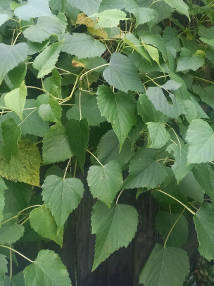 The winner of Best Vine 2014 was this thing that I thought was wild grape. In July, I stumbled across a document online that showed pictures of some of the most invasive exotic plants in some eastern state. Lo and behold, there was my "wild grape". It turned out to be porcelain berry (Ampelopsis brevipedunculata), and it's native to eastern Asia. It is highly invasive in the States. I have removed all branches from the fence and chopped the main "trunks". I'll be keeping an eye our for offshoots.
The winner of Best Vine 2014 was this thing that I thought was wild grape. In July, I stumbled across a document online that showed pictures of some of the most invasive exotic plants in some eastern state. Lo and behold, there was my "wild grape". It turned out to be porcelain berry (Ampelopsis brevipedunculata), and it's native to eastern Asia. It is highly invasive in the States. I have removed all branches from the fence and chopped the main "trunks". I'll be keeping an eye our for offshoots.
So now that that's out of the way, let the awards begin!
Best Canopy Tree
Tall trees that grow above all others.
 American sycamore
Current height: 7'7" (max: 90')
Planted: 2013 January
American sycamore
Current height: 7'7" (max: 90')
Planted: 2013 January
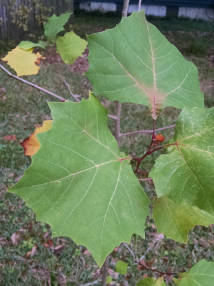 The 2015 winner in this category can't be stopped after taking the category last year. It grew another 3'5" this year, an increase of 82%! The growth since 2013 is polynomial.
The 2015 winner in this category can't be stopped after taking the category last year. It grew another 3'5" this year, an increase of 82%! The growth since 2013 is polynomial.
Red maple, east
Current height: 6'10" (max: 60')
Planted: 2011 December
This Arbor Day Foundation stick has increased its height by 52% this year (or 2'4"), not enough to win the category but still very impressive.
Baldcypress
Current height: 4'11" (max: 80')
Planted: 2013 March
Growth continues to slow down for this little cypress. It grew 1'5" in 2015, an increase of 40%.
Tuliptree, south
Current height: 4'11" (max: 100')
Planted: 2013 October
A mere 7" of growth equals a 13% increase for this little guy. The two tuliptrees are consistent so far as they each grew the same amount in 2014 as they did in 2015 (7" and 4" respectively).
Best Understory Tree
Shorter trees that grow under canopy trees or at the forest edge. Or maybe just by themselves.
 Eastern redbud, Chicken Yard
Current height: 6'1" (max: 30')
Planted: 2011 October
Eastern redbud, Chicken Yard
Current height: 6'1" (max: 30')
Planted: 2011 October
 Of all winners, this Eastern redbud had the largest increase over 2014, a whopping 103%! This amounts to 3'1" of growth in 2015, rivalling the sycamore's increase. Not too shabby.
Of all winners, this Eastern redbud had the largest increase over 2014, a whopping 103%! This amounts to 3'1" of growth in 2015, rivalling the sycamore's increase. Not too shabby.
Eastern redbud, street-side
Current height: 2'0" (max: 30')
Planted: 2015 January
The redbuds were on a roll this year. This new one grew 85% (11") since I planted it in January.
Carolina buckthorn, south
Current height: 5'2" (max: 30')
Planted: 2013 January
A 1'8" increase means 48% increase for this wonderful little guy. It also had a great year for berry-production.
American hornbeam
Current height: 13'10" (max: 40')
Planted: 2013 October
Although it grew 3'2" this year, this was only a 30% increase. This is the plant that made me rethink how I rank everything. It would have won the category if only absolute height increase was used. Sorry, hornbeam
Southern redcedar
Current height: 12'2" (max: 40')
Planted: 2011 October
Vertical growth is slowing down for the 2014 winner, only increasing 2'10" (30%) this year.
Best Shrub
Not quite what I would call a tree due to their height and shape.
 Groundsel
Current height: 7' (max: 12')
Planted: 2014 May
Groundsel
Current height: 7' (max: 12')
Planted: 2014 May
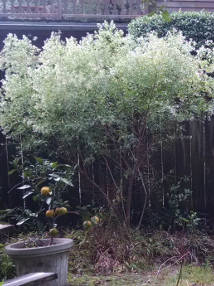 Another year of explosive growth for the groundsel: 3' and 75%. I think the shade on the north side of the fence where I planted it helped prod it to grow up faster. It's bushy and lovely.
Another year of explosive growth for the groundsel: 3' and 75%. I think the shade on the north side of the fence where I planted it helped prod it to grow up faster. It's bushy and lovely.
Virginia sweetspire, north
Current height: 3'11" (max: 6')
Planted: 2013 December
This particular plant grew by 88% in height since a year ago (1'10"). So why didn't it win the category since the groundsel only grew 75%? The answer is that only one branch grew that tall, and despite the sweetspire's fall color, the groundsel impressed me a lot more with its bushiness.
American beautyberry, deck
Current height: 4'0" (max: 6+')
Planted: 2014 December
This new beautyberry grew 1'6" this year (60%). I've increased the number of beautyberries in the yard because they do really well.
Southern arrowwood, middle
Current height: 11'11" (max: 15')
Planted: 2013 April
This is last year's winner, but its 31% increase in height (2'10") was no match for the groundsel.
American beautyberry, west
Current height: 8'1" (max: 6+')
Planted: 2011 November
The 2013 winner continues to grow upward, increasing by 1'5" (21%). Both this and the east shrub will be pruned at the end of winter to promote a denser form with more branching, likely ending their chances in future competitions since they are as big as I would like them in their location.
Best Wildflower
Only native perennials and annuals allowed.
 Partridge pea
Sowed: 2013 March (originally)
Partridge pea
Sowed: 2013 March (originally)
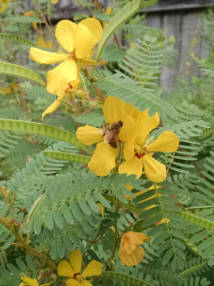 The 2014 winner wins again! There's just no beating this pioneer species.
The 2014 winner wins again! There's just no beating this pioneer species.
Horsemint
Sowed: 2014-15 ?
It's difficult to rank the remaining plants, but I think the unusual flowers of horsemint should make the cut.
Scarlet sage
Sowed: 2015 August
This 2013 winner might make a comeback as I've sowed seeds from plants I found on LSU's Campus Lake. In just under 2 months from sowing, they started growing flower buds.
Ironweed
A sturdy plant, ironweed is loved by all the bees.
Stoke's aster
I could have chosen bundleflower, cardinal flower, or blanket flower to round out this category, but I am intrigued by the petals of my Stoke's aster.
Best Edible
Things I can eat. The previous category ("Best Vegetable/Fruit") is now expanded to include leaf infusions.
 Yaupon
Yaupon
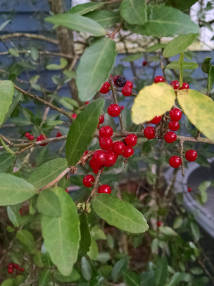 My personal discovery that this plant's leaves are used to make tea is what sealed it for me. This is the only North American species that contains caffeine and is a close relative of yerba mate.
My personal discovery that this plant's leaves are used to make tea is what sealed it for me. This is the only North American species that contains caffeine and is a close relative of yerba mate.
Basil
Good ol' basil is a close runner-up. It's an easy plant to grow, but I've had trouble getting it to go to seed so I can avoid buying a new plant every year.
Tuscan blue rosemary
Current height: 2'8" (max: 4')
Planted: 2011 November
I imagine this plant would like more sun, but it does well enough for itself.
Bay laurel
Planted: 2014 October
Not a native but important for many soup-like items in the kitchen.
Cilantro
It's hard to remember how well these plants did since they only grew in the spring, but they expanded their range into the alley this year.
Best Vine
These grow up things like fences.
 Crossvine
Planted: 2014 December
Crossvine
Planted: 2014 December
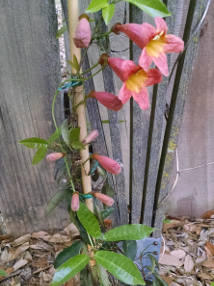 After the sham which was last year's winner (see Biggest Scandal above), this category has been redeemed by crossvine. This one is a "Tangerine Dream" cultivar.
After the sham which was last year's winner (see Biggest Scandal above), this category has been redeemed by crossvine. This one is a "Tangerine Dream" cultivar.
Climbing cucumber
This vine was introduced by a bird's butt. I read that the fruit are edible while still green, but I never tried one.
Maypop
Planted: 2014 February
This vine is turning out to be very resilient with multiple shoots coming out of the ground around the original planting. It's climbed high into a crepe myrtle. It didn't flower this year, but I'm hoping it will in 2016.
Virginia creeper
The multitude of Virginia creeper continues to grow up the backyard fences. So far, it has behaved itself.
Best Grass
This category, now in its second year, is beginning to get more nominations.
 Inland seaoats
Sowed: 2013 January-May
Inland seaoats
Sowed: 2013 January-May
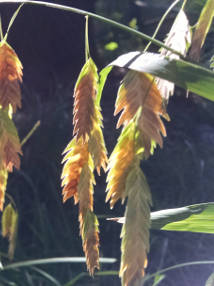 The inland seaoats continue to spread and grow. They went to seed again which will help them spread farther into the yard.
The inland seaoats continue to spread and grow. They went to seed again which will help them spread farther into the yard.
Broomsedge
The broomsedge seeds continue to spread. One day, I hope to be able to compare it to little bluestem to see which is which.
Deertongue
I've started to see this plant's value in the landscape. It is remarkably sturdy in both sun and shade.
Gulf muhly
The number of plants has risen from two to six this year. I can't say they have particularly grown all that much, but they look pretty cool and will be breath-taking when they collectively flower next year.
Best Fall Color
A new category this year will highlight all the ways fall colors can appear in south Louisiana.
 Winged sumac
Color: red
Planted: 2015 October
Winged sumac
Color: red
Planted: 2015 October
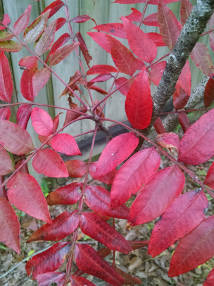 Even for a year with very little fall color, this winged sumac turned completely red.
Even for a year with very little fall color, this winged sumac turned completely red.
Virginia sweetspire
Color: orange, red, yellow
Planted: 2013 December
Not as impressive as they were last year, they still looked pretty good.
Possumhaw viburnum
Color: red
Planted: 2015 October
A new plant with few leaves, but they did turn colors before they dropped off.
Virginia creeper
Color: orange, yellow
The weather wasn't as cooperative this year for the Virginia creeper, but some color still did appear.
Now let's see how my last year's predictions for top performers did in 2015.
2014's up-and-coming for 2015
Sparkleberry
Current height: 1'5" (max: 10')
Planted: 2014 August
Rating: poor
I did kinda predict that it wouldn't grow, and I was right. I lost sight of this one because all the blue mistflower obscured it. It grew a measly 3" this year, a lot less than I thought.
American sycamore
Current height: 7'7" (max: 90')
Planted: 2013 January
Rating: very good
I knew it! This is one fast-growing species.
Southern arrowwood
Current height: 11'11" (max: 15')
Planted: 2013 April
Rating: very good
As predicted, it did cross-pollinate and produce fruit. It got, not only taller, but wider. I may be pruning it this winter to create a more compact form.
Southern redcedar
Current height: 12'2" (max: 40')
Planted: 2011 October
Rating: very good
I guess this one was obviously going to do well. I use it as my living Christmas tree. It was harder to string lights on it this year because of its height.
Groundsel
Current height: 7'0" (max: 12')
Planted: 2014 May
Rating: very good
I was correct about this groundsel reaching its full potential in 2015. It still has 5' or so that it can grow, but it got there very quickly.
2015's up-and-coming for 2016
And finally, to wrap up this awards show, I'd like to predict five potential break-out plants for 2016.
Elderberry
Current height: ~8" (max: 10')
Sowed: 2015 July
 This is a gimme. Something will be seriously wrong with the world if the elderberry don't grow in 2016.
This is a gimme. Something will be seriously wrong with the world if the elderberry don't grow in 2016.
Red mulberry
Current heights: 11", 1'5" (max: 20')
Planted: 2014 December
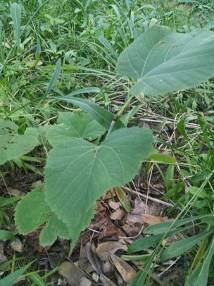 They're already taller than I expected, but 2016 may prove just how fast red mulberry can grow.
They're already taller than I expected, but 2016 may prove just how fast red mulberry can grow.
Crossvine
Planted: 2014 December
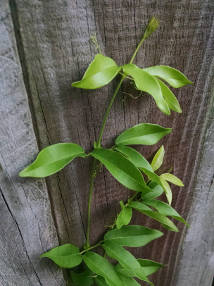 In a year, it's already climbed up to within a foot of the top of the fence. Being evergreen should give this plant an advantage.
In a year, it's already climbed up to within a foot of the top of the fence. Being evergreen should give this plant an advantage.
American beautyberry
Current height: [various] (max: 6')
Planted: [various]
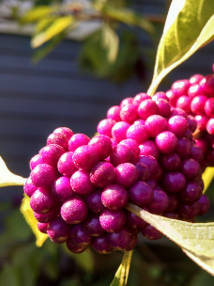 They're everywhere, so this is a sweeping statement of a prediction. I am mostly referring to the three I planted under the Southern magnolia amongst the under-performing red buckeye.
They're everywhere, so this is a sweeping statement of a prediction. I am mostly referring to the three I planted under the Southern magnolia amongst the under-performing red buckeye.
Possumhaw viburnum
Current height: 5'8" (max: 10')
Planted: 2015 October
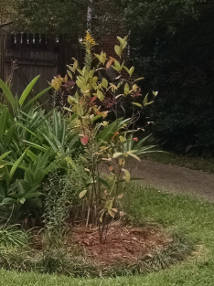 Judging from how some leaves already grew in the Christmas 2015 warm spell, I think this plant is ready to bust out in 2016.
Judging from how some leaves already grew in the Christmas 2015 warm spell, I think this plant is ready to bust out in 2016.
 The winner of Best Vine 2014 was this thing that I thought was wild grape. In July, I stumbled across a document online that showed pictures of some of the most invasive exotic plants in some eastern state. Lo and behold, there was my "wild grape". It turned out to be porcelain berry (Ampelopsis brevipedunculata), and it's native to eastern Asia. It is highly invasive in the States. I have removed all branches from the fence and chopped the main "trunks". I'll be keeping an eye our for offshoots.
The winner of Best Vine 2014 was this thing that I thought was wild grape. In July, I stumbled across a document online that showed pictures of some of the most invasive exotic plants in some eastern state. Lo and behold, there was my "wild grape". It turned out to be porcelain berry (Ampelopsis brevipedunculata), and it's native to eastern Asia. It is highly invasive in the States. I have removed all branches from the fence and chopped the main "trunks". I'll be keeping an eye our for offshoots.
 American sycamore
Current height: 7'7" (max: 90')
Planted: 2013 January
American sycamore
Current height: 7'7" (max: 90')
Planted: 2013 January
 The 2015 winner in this category can't be stopped after taking the category last year. It grew another 3'5" this year, an increase of 82%! The growth since 2013 is polynomial.
The 2015 winner in this category can't be stopped after taking the category last year. It grew another 3'5" this year, an increase of 82%! The growth since 2013 is polynomial.
 Eastern redbud, Chicken Yard
Current height: 6'1" (max: 30')
Planted: 2011 October
Eastern redbud, Chicken Yard
Current height: 6'1" (max: 30')
Planted: 2011 October
 Of all winners, this Eastern redbud had the largest increase over 2014, a whopping 103%! This amounts to 3'1" of growth in 2015, rivalling the sycamore's increase. Not too shabby.
Of all winners, this Eastern redbud had the largest increase over 2014, a whopping 103%! This amounts to 3'1" of growth in 2015, rivalling the sycamore's increase. Not too shabby.
 Groundsel
Current height: 7' (max: 12')
Planted: 2014 May
Groundsel
Current height: 7' (max: 12')
Planted: 2014 May
 Another year of explosive growth for the groundsel: 3' and 75%. I think the shade on the north side of the fence where I planted it helped prod it to grow up faster. It's bushy and lovely.
Another year of explosive growth for the groundsel: 3' and 75%. I think the shade on the north side of the fence where I planted it helped prod it to grow up faster. It's bushy and lovely.
 Partridge pea
Sowed: 2013 March (originally)
Partridge pea
Sowed: 2013 March (originally)
 The 2014 winner wins again! There's just no beating this pioneer species.
The 2014 winner wins again! There's just no beating this pioneer species.
 Yaupon
Yaupon
 My personal discovery that this plant's leaves are used to make tea is what sealed it for me. This is the only North American species that contains caffeine and is a close relative of yerba mate.
My personal discovery that this plant's leaves are used to make tea is what sealed it for me. This is the only North American species that contains caffeine and is a close relative of yerba mate.
 Crossvine
Planted: 2014 December
Crossvine
Planted: 2014 December
 After the sham which was last year's winner (see Biggest Scandal above), this category has been redeemed by crossvine. This one is a "Tangerine Dream" cultivar.
After the sham which was last year's winner (see Biggest Scandal above), this category has been redeemed by crossvine. This one is a "Tangerine Dream" cultivar.
 Inland seaoats
Sowed: 2013 January-May
Inland seaoats
Sowed: 2013 January-May
 The inland seaoats continue to spread and grow. They went to seed again which will help them spread farther into the yard.
The inland seaoats continue to spread and grow. They went to seed again which will help them spread farther into the yard.
 Winged sumac
Color: red
Planted: 2015 October
Winged sumac
Color: red
Planted: 2015 October
 Even for a year with very little fall color, this winged sumac turned completely red.
Even for a year with very little fall color, this winged sumac turned completely red.
 This is a gimme. Something will be seriously wrong with the world if the elderberry don't grow in 2016.
This is a gimme. Something will be seriously wrong with the world if the elderberry don't grow in 2016.
 They're already taller than I expected, but 2016 may prove just how fast red mulberry can grow.
They're already taller than I expected, but 2016 may prove just how fast red mulberry can grow.
 In a year, it's already climbed up to within a foot of the top of the fence. Being evergreen should give this plant an advantage.
In a year, it's already climbed up to within a foot of the top of the fence. Being evergreen should give this plant an advantage.
 They're everywhere, so this is a sweeping statement of a prediction. I am mostly referring to the three I planted under the Southern magnolia amongst the under-performing red buckeye.
They're everywhere, so this is a sweeping statement of a prediction. I am mostly referring to the three I planted under the Southern magnolia amongst the under-performing red buckeye.
 Judging from how some leaves already grew in the Christmas 2015 warm spell, I think this plant is ready to bust out in 2016.
Judging from how some leaves already grew in the Christmas 2015 warm spell, I think this plant is ready to bust out in 2016.


